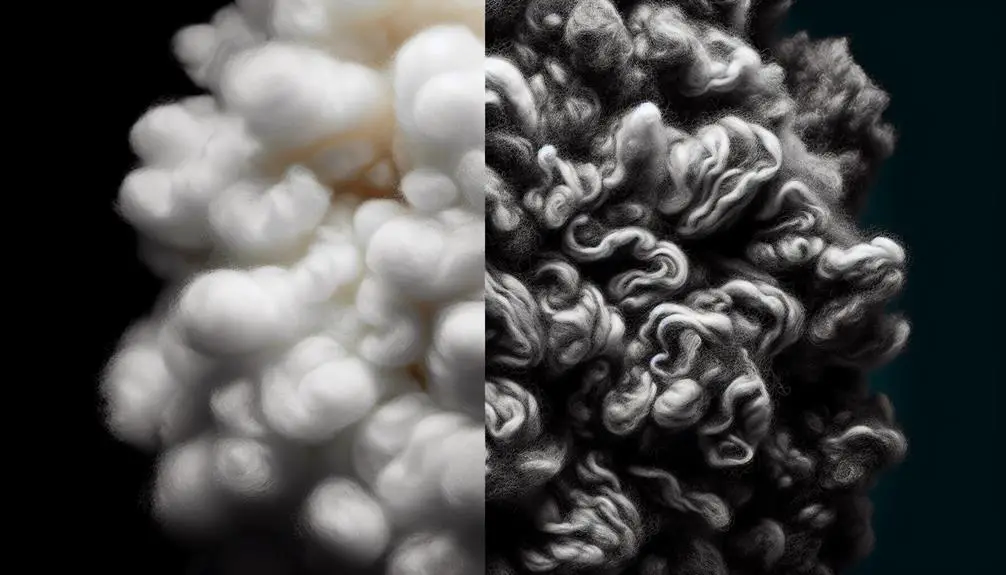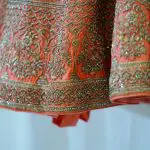When it comes to choosing between fleece and wool, understanding their differences can be crucial in making an informed decision. The distinction between these two materials goes beyond just warmth; it's about the very fabric of their being.
So, let's unravel the unique properties that set fleece and wool apart, shedding light on which might be the better pick for your next outdoor adventure or cozy winter evening.
Table of Contents
Key Takeaways
- Wool is water repellent with lanolin, while fleece lacks natural water resistance.
- Wool provides superior insulation, even when wet, ideal for extreme cold climates.
- Fleece excels in breathability and quick drying, suitable for activities with moisture exposure.
- Fleece is more durable due to synthetic fibers, while wool requires delicate care for longevity.
Origins and Production Methods
Origins and Production Methods differ significantly between fleece and wool, showcasing the contrast between a synthetic fabric and a natural fiber.
Wool, a classic material used for garments for thousands of years, is sourced from sheep and remains unprocessed. On the other hand, fleece, a more modern innovation from the late 20th century, is a synthetic fabric made of polyester fibers.
The production methods for these two materials also vary greatly. Wool comes directly from sheep, where it's sheared, cleaned, spun, and woven into wool garments. In contrast, fleece is manufactured by melting polyester fibers and then weaving them together to create the fabric.
The origins of wool trace back to ancient times, highlighting its traditional and natural essence, whereas fleece's roots are firmly planted in the realm of modernity, being a product of synthetic innovation. This stark difference in origins and production methods underscores the unique qualities of wool as a natural fiber and fleece as a synthetic fabric.
Fiber Characteristics and Properties
When comparing the fiber characteristics and properties of wool and fleece, one can distinguish their unique qualities that make them distinct materials for various uses. Wool, a natural fiber sourced from sheep, contains lanolin, making it water repellent and better at insulating even when wet. On the other hand, fleece, a synthetic fabric typically made of polyester or a blend, lacks natural water resistance. Here are some key points to consider:
- Wool is known for its durability and renewability, making it a sustainable choice.
- Fleece, while lightweight and soft like wool, isn't as water-resistant and may release harmful plastic microfibers into the environment.
- Wool offers superior wind insulation properties and has been utilized for millennia.
- Fleece, however, excels at drying quickly when wet and efficiently wicking away sweat.
- Wool's lanolin content provides natural moisture-wicking properties, whereas fleece lacks this feature.
Understanding these fiber characteristics and properties can help in selecting the most suitable material for specific needs and preferences.
Insulation and Thermal Regulation
In exploring the insulation and thermal regulation properties of wool and fleece, one can appreciate the unique advantages each material offers in different weather conditions. Wool takes the lead in providing insulation even when wet, making it a top choice for extreme cold climates where retaining warmth is crucial. On the other hand, fleece excels in its lightweight and breathable nature, ideal for milder conditions where moisture-wicking properties are essential.
Wool vs Fleece Insulation and Thermal Regulation:
| Properties | Wool | Fleece |
|---|---|---|
| Insulation in wet conditions | Excellent due to lanolin content | Dries faster when wet |
| Water-resistant | Yes | Lacks natural repellency |
| Thermal regulation | Retains warmth even when wet | Lightweight and breathable |
| Ideal for | Extreme cold climates | Milder conditions |
Wool's ability to provide insulation even in wet conditions and fleece's lightweight, moisture-wicking properties make them both valuable choices, each excelling in different scenarios.
Moisture Management and Water Resistance
With superior water resistance due to its lanolin coating, wool outperforms fleece in moisture management and durability. While fleece dries quicker when completely wet, wool holds off water absorption longer, making it ideal for prolonged exposure to wet conditions. Additionally, wool retains insulation even when wet, providing warmth in damp environments. On the other hand, fleece, being lightweight and quick-drying, is more practical for activities with frequent exposure to moisture. However, when it comes to water resistance, wool excels, making it the better choice for extended periods in wet conditions.
- Wool holds off water absorption longer due to its lanolin coating.
- Fleece dries substantially quicker than wool when completely wet.
- Wool retains insulation even when wet, offering warmth in damp conditions.
- Fleece is lighter and dries faster than wool, suitable for activities with frequent moisture exposure.
- Wool is superior in water resistance, making it ideal for prolonged exposure to wet conditions.
Durability and Maintenance
Transitioning from discussing moisture management and water resistance, let's now explore the durability and maintenance differences between fleece and wool. When comparing the two materials, fleece emerges as the more durable option due to its synthetic fibers that are resistant to wear and tear. It is ideal for everyday use and outdoor activities where longevity is crucial. On the other hand, wool, while also durable, requires more delicate care as it can be susceptible to damage from friction. Proper maintenance is essential to ensure that wool retains its shape and optimal insulation properties over time.
To highlight this comparison, let's delve into a table showcasing the key differences between wool and fleece in terms of durability and maintenance:
| Aspect | Wool | Fleece |
|---|---|---|
| Durability | Requires delicate care | Resistant to wear and tear |
| Longevity | Proper maintenance needed | Retains shape over time |
| Insulation Properties | Maintenance crucial for performance | Reliable insulation properties |
Frequently Asked Questions
Which Is Better Wool or Fleece?
I liken choosing between wool and fleece to picking the right tool for the job. Wool shines in cold and wet conditions for superior insulation. Fleece, on the other hand, excels at managing moisture and drying quickly.
Is a Wool Blanket Warmer Than Fleece?
Yes, a wool blanket is warmer than fleece. Wool's natural insulating properties and heat retention make it superior for trapping warmth. Even when wet, wool blankets provide excellent insulation for staying cozy in cold temperatures.
Is Fleece Good for Winter?
Yes, fleece is a fantastic choice for winter! It offers lightweight warmth, quick drying, and is great for layering. One interesting statistic is that fleece is budget-friendly, making it a practical and cozy option for chilly days.
Is Fleece Actually Warmer?
Yes, fleece is definitely warmer. It traps heat efficiently, providing great insulation. The thickness and density of fleece make it ideal for cold weather. I find fleece to be my go-to for staying cozy in winter.
- Traditional Fabrics: A Cultural Exploration - July 17, 2024
- The History of Fabric Dyeing: Techniques and Trends - July 17, 2024
- Renowned Fabric Designers: Innovators and Pioneers - July 17, 2024








